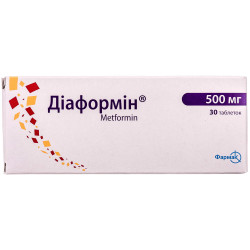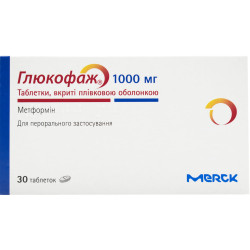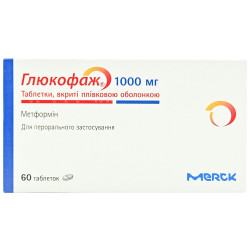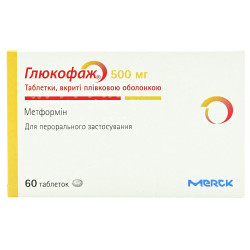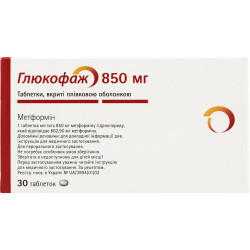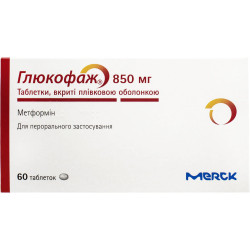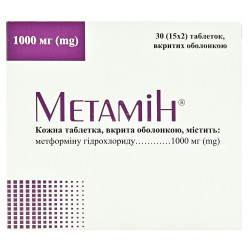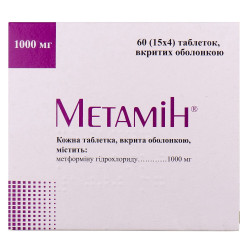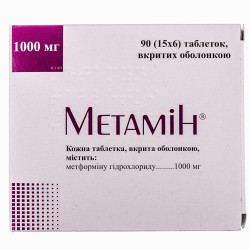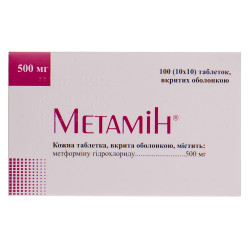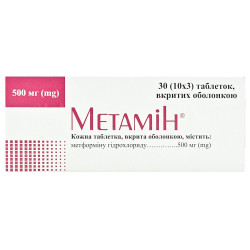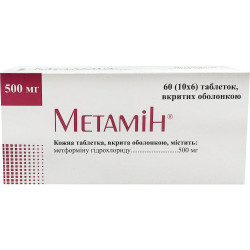



- Stock: In Stock
- Model: 183663
0% Customers recommend this product
-
5 Awesome0%
-
4 Great0%
-
3 Average0%
-
2 Bad0%
-
1 Poor0%
Reviews Over Diaformin of the tab. p / captivity. obol. 1000 mg No. 60
- (0)
Total Reviews (0)
click here write review to add review for this product.
Report this review.
Description
Diaformin is appointed for treatment of diabetes 2 types at inefficiency of a dietotherapy and mode of physical activities, especially at patients with excessive body weight;
- as monotherapy or combination therapy together with other oral hypoglycemic means, or together with insulin for treatment of adults;
- as monotherapy or combination therapy with insulin for treatment of children 10 years and teenagers are more senior.
For reduction of complications of diabetes at adult patients with diabetes 2 types and excess body weight as medicament of the first line after an inefficient dietotherapy.
Structure
active ingredient: metformin hydrochloride;
1 tablet, film coated, on 1000 mg contains 1000 mg of metformin of a hydrochloride;
excipients: sodium krakhmalglikolit (type A), povidone (K-30), starch corn, silicon dioxide colloidal anhydrous, magnesium stearate;
film cover of Opadry White 04 G58897: gipromelloza, talc, titan dioxide (E 171), macrogoal 6000, propylene glycol.
Metformin – biguanide with anti-hyper glycemic effect. Reduces in blood plasma both the initial level of glucose, and glucose level after meal. Does not stimulate secretion of insulin and does not cause the hypoglycemic effect mediated by this mechanism.
Metformin acts within three ways:
leads- to decrease in producing glucose in a liver at the expense of inhibition of a gluconeogenesis and a glycogenolysis;
- is improved by sensitivity to insulin in muscles that leads to improvement of capture and utilization of peripheral glucose;
- absorption of glucose in intestines detains.
intracellular synthesis of a glycogen, influencing a glikogensintetaza. Increases transport ability of all known types of membrane carriers of glucose (GLUT).
Irrespective of the action has positive impact on metabolism of lipids on a glycemia, metformin: reduces the content of the general cholesterol, lipoproteins of low density and triglycerides.
Contraindication
- Hypersensitivity to metformin or to any other component of drug;
- diabetic ketoacidosis, diabetic prekoma;
- a renal failure moderated (a stage ІІІ b) and heavy degree or a renal failure (clearance of creatinine <45 ml/min. or SKF <45 ml/min. / 1.73 m 2 );
- acute conditions proceeding with risk of developing renal failures such, as: organism dehydration, serious infectious diseases, shock;
- a disease which can lead to development of a hypoxia of fabrics (especially acute diseases or exacerbations of a chronic disease): dekompensirovanny heart failure, respiratory insufficiency, recently postponed myocardial infarction, shock;
- liver failure, acute alcoholic poisoning, alcoholism.
Route of administration and doses.
Adult
Monoterapiya'sor combination therapy together with other oral hypoglycemic means.
Usually initial dose makes 500 mg or 850 mg 2–3 times a day in time or after meal.
In 10–15 days of the carried-out treatment a dose needs to be modified according to results of measurements of level of glucose in blood serum.
Slow increase in a dose promotes decrease in side effects from a digestive tract.
Maximum recommended dose makes 3000 mg a day in 3 receptions.
At treatment by high doses are applied Diaformin, by tablets, film coated, on 1000 mg.
in case of transition to the Diaformin medicament treatment needs to stop reception of other antidiabetic means.
Combination therapy together with insulin.
in blood metformin and insulin can be applied To achievement of the best control of level of glucose in the form of combination therapy. Usually initial dose makes 500 mg or 850 mg of the medicament Diaformin 2–3 times a day while the dose of insulin is selected according to results of measurement of level of glucose in blood.
Children .
Monoterapiya'sor combination therapy together with insulin.
to use the Drug Diaformin to children 10 years and to teenagers are more senior. Usually initial dose makes 500 mg or 850 mg of the medicament Diaformin of 1 times a day in time or after meal. In 10–15 days of the carried-out treatment the dose needs to be modified according to results of measurements of level of glucose in blood serum.
Slow increase in a dose promotes decrease in side effects from a digestive tract.
Maximum recommended dose makes 2000 mg a day, divided into 2–3 receptions.
At patients of advanced age the deterioration in function of kidneys is possibletherefore the dose of metformin needs to be selected on the basis of assessment of function of kidneys which needs to be seen off regularly (see the section "Features of Use").
Patients with a renal failure. Diaformin patients can apply with a moderate renal failure, IIIa stage (clearance of creatinine of 45-59 ml/min. or SKF of 45-59 ml/min. / 1.73 m 2 ), only in case of lack of other conditions which can increase risk of developing lactoacidosis, and with the subsequent correction of a dose: the initial dose makes 500 mg or 850 mg of metformin of a hydrochloride of 1 times a day. The maximum dose makes 1000 mg a day and has to be divided into 2 receptions. It is necessary to carry out careful monitoring of function of kidneys (each 3–6 months).
If the clearance of creatinine or SKF decreases to <45 ml/min. or 45 ml/min. / 1.73 m 2 respectively, it is necessary to stop metformin use immediately.
Overdose.
byAt use of medicament in a dose of 85 g of development of a hypoglycemia it was not observed. However in this case development of lactoacidosis was observed. Considerable exceeding a dose of metformin or contributing factors of risk can lead to developing of lactoacidosis. Lactoacidosis is medical emergency and he should be treated in a hospital. The most effective method for removal from an organism of a lactate and metformin is the hemodialysis.
Side reactions.
Most frequent undesirable reactions, especially in an initiation of treatment, are nausea, vomiting, diarrhea, an abdominal pain, lack of appetite. These symptoms, as a rule, disappear independently. For prevention of emergence of by-effects from a digestive tract the slow increase in a dosage and use of medicament 2–3 times a day in time or after meal is recommended.
Feature of use
Use during pregnancy or feeding by a breast
Pregnancy. Uncontrollable diabetes during pregnancy (gestational or constant) increases risk of developing congenital anomalies and perinatal lethality. There are limited these uses of metformin to pregnant women who do not point to the increased risk of congenital anomalies. Preclinical trials did not reveal negative impact on pregnancy, embryonic development, childbirth and postnatal development. When planning pregnancy and also in case of approach of pregnancy it is necessary to cancel therapy by metformin, to tell the doctor and to appoint insulin therapy for maintenance of level of glucose in blood as close as possible to normal for reduction of risk of development of defects of a fruit.
Lactation. Metformin is removed with breast milk. At newborns/children of chest age the side effects were not observed. In view of insufficiency of data on safety the feeding by a breast is not recommended during therapy by the medicament Diaformin. The decision concerning the feeding termination by a breast needs to be made taking into account need of administration of medicament for mother and potential risk for the child.
Fertility. Metformin did not affect fertility of animals at use in doses of 600 mg/kg / in day that exceeds almost three times the maximum daily dose which is recommended for use for the person and is calculated proceeding from body surface area.
Children
children can use the Drug Diaformin 10 years are more senior.
Ability to influence speed of response at control of motor transport or other mechanisms
Diaformin does not influence the speed of reactions at control of motor transport and work with other mechanisms as monotherapy by medicament does not cause a hypoglycemia.
However should apply with care metformin in a combination with other hypoglycemic means (sulphonylurea derivatives, insulin or meglitinida) because of risk of development of a hypoglycemia.
Interaction with other medicines and other types of interactions.
Combination which are not recommended to be applied.
Acute drunkenness is associated with the increased risk of lactoacidosis, especially in cases of starvation or observance of a low-calorie diet and also in a liver failure. At the Diaformin medicament treatment it is necessary to avoid the alcohol intake and medicines containing alcohol.
Iodinated X-ray contrast substances. Intravenous use of iodinated X-ray contrast substances can lead to a renal failure and, as a result, to cumulation of metformin and increase in risk of developing lactoacidosis.
to Patients with SKF> 60 ml/min. / 1.73 m 2 use of metformin should be stopped to or during a research and not to renew earlier than in 48 hours after the research and only after repeated assessment of function of kidneys and confirmation of lack of further aggravation of symptoms of kidneys (see the section "Features of Use").
to Patients with a moderate renal failure (SKF of 45-60 ml/min. / 1.73 m 2 ) use of metformin should be stopped in 48 hours prior to administration of iodinated X-ray contrast substances and not to renew earlier than in 48 hours after carrying out a research and only after repeated assessment of function of kidneys and confirmation of lack of further aggravation of symptoms of kidneys.
Storage conditionsto Store
at a temperature not above 25ºС. to Store
out of children's reach.
Expiration date - 3 years.
not to use medicament after the termination of the expiration date specified on packing.
Specifications
| Characteristics | |
| Active ingredients | Metformin |
| Amount of active ingredient | 1000 mg |
| Applicant | Pharmak |
| Code of automatic telephone exchange | A10BA02 Metformin |
| Interaction with food | In time |
| Light sensitivity | Not sensitive |
| Market status | The branded generic |
| Origin | Chemical |
| Prescription status | According to the prescription |
| Primary packing | blister |
| Producer | PUBLIC JOINT STOCK COMPANY PHARMAK |
| Quantity in packing | 60 tablets (6 blisters on 10 pieces) |
| Release form | tablets for internal use |
| Route of administration | Oral |
| Sign | Domestic |
| Storage temperature | from 5 °C to 25 °C |
| Trade name | Diaformin |












